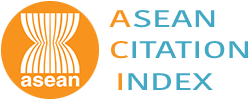การประยุกต์ใช้ดัชนีชีวภาพสัตว์หน้าดินประเมินคุณภาพแหล่งน้ำ : กรณีศึกษาคลองบางบาล จังหวัดพระนครศรีอยุธยา
คำสำคัญ:
สัตว์หน้าดินขนาดใหญ่, ดัชนีชีวภาพ, คุณภาพน้ำ, คลองบางบาล, จังหวัดพระนครศรีอยุธยาบทคัดย่อ
วัตถุประสงค์และที่มา : การศึกษานี้มีวัตถุประสงค์เพื่อศึกษาความหลากหลายของสัตว์หน้าดินและการประยุกต์ใช้ดัชนีชีวภาพ BMWPthai score (Biological Monitoring Working Party) และ ASTPthai (Average Score Per Taxa) ประเมินคุณภาพน้ำในคลองบางบาล จังหวัดพระนครศรีอยุธยา
วิธีดำเนินการวิจัย : เก็บตัวอย่างสัตว์หน้าดินจำนวน 4 สถานี ในเดือนมิถุนายน 2563 (ฤดูแล้ง) เดือนกรกฎาคมและสิงหาคม 2563 (ต้นฤดูฝน) และเดือนกันยายน 2563 (ปลายฤดูฝน) ด้วยเครื่องมือตักดิน (Ekman Grab) ตรวจวัดคุณภาพน้ำในภาคสนาม ได้แก่ ความลึก ความโปร่งแสงของน้ำ อุณหภูมิ ความเป็นกรด-ด่าง ปริมาณออกซิเจนละลายน้ำ ค่าการนำไฟฟ้าและปริมาณของแข็งที่ละลายน้ำ รวมทั้งเก็บดินมาวิเคราะห์ขนาดอนุภาคและปริมาณสารอินทรีย์ในดินในห้องปฏิบัติการ
ผลการวิจัย : พบสัตว์หน้าดินทั้งสิ้น 19 ชนิด 17 สกุล 13 วงศ์ สัตว์หน้าดินกลุ่มเด่น ได้แก่ ไส้เดือนน้ำในวงศ์ Tubificidae (Branchiura sp. และ Tubifex sp.) วงศ์ Naididae (Dero sp.) โพลีคีตวงศ์ Nepthyidae (Nepthys sp.) วงศ์ Nereididae (Namalycastis sp., Nereis sp. และ Dendronereis sp.) หอยฝาเดียววงศ์ Viviparidae (Mekongia swainsoni brueri) หอยสองฝาวงศ์ Corbiculidae (Corbicula sp.) ครัสเตเชียนพวกกุ้งฝอยวงศ์ Palaemonidae (Macrobrachium sp.) และตัวอ่อนแมลงน้ำวงศ์ Chironomidae (Chironomus sp.) ดัชนีชีวภาพ BMWPthai score และ ASTPthai บ่งชี้ว่าคลองบางบาลจังหวัดพระนครศรีอยุธยาจัดเป็นแหล่งน้ำประเภท 4 (คุณภาพน้ำเสื่อมโทรม) ตามเกณฑ์มาตรฐานคุณภาพน้ำในแหล่งน้ำผิวดิน
สรุปผลการวิจัย : การศึกษานี้สามารถสรุปได้ว่าดัชนีชีวภาพ BMWPthai score และ ASTPthai สามารถนำมาใช้ประเมินคุณภาพแหล่งน้ำได้ ซึ่งแสดงความสัมพันธ์กับความหลากหลายชนิด (ระดับวงศ์) ความหนาแน่น ดัชนีความชุกชุมของชนิด ดัชนีความหลากหลายทางชนิด และดัชนีความสม่ำเสมอทางชนิดของสัตว์หน้าดิน
เอกสารอ้างอิง
Angsupanich, S., Amnaj Siripech, A. & Charoenpornthip, M. (2000). Macrobenthic Fauna Community and Optimum Sampling Protocol for the Lower Part of Inner Songkhla Lake, Southern Thailand. Final Report Songkla: Prince of Songkla University. (in Thai)
Brandit, R.A.M. (1974). The non-marine aquatic Mollusca of Thailand. Arch Molluskenkunde, 105: 1-423.
Brinkhurst, R.O. & Jamieson, B.G.M. (1971). Aquatic Oligochaeta of the World. Toronto: University of Toronto Press.
Brinkhurst, R.O. (1971). A Guide for the Identification of British Aquatic, 2nd ed. Toronto: Titus Wilson and Sons LTD.
Chaomeepurm, T. (2016). Physical properties and structures of river bank sediments in Bang Ban canal, Amphoe Bang Ban, Changwat Phra Nakhon Si Ayutthaya. Senior project. Chulalongkorn University. (in Thai)
Chartchumni, B., Rangsiwiwat, A., Kaewdonree, S. & Rayan, S. (2017). Species Diversity of Benthic Macroinvertebrate and Application as Bioindicators of Water Quality in Nam Oun Reservoir, Sakon Nakhon Province. Burapha Science Journal, 22(3), 83-94. (in Thai)
Fauchald, K. (1977). The Polychaete Worms Definitions and Keys to the Orders, Families and Genera. Los Angeles: The Natural History Museum.
Fauchald, K. & Jumars, P.A. (1979). The diet of worms: A study of polychaete feeding guilds. Oceanography and Marine Biology Annual Review, 17, 193–284.
Kanchana-Aksorn, W. & Petpiroon, S. (2006). Benthic macrofauna in the lower Chao Phraya river. In Proceedings of 44th Kasetsart University Annual Conference: Fisheries. (pp. 44-51). Bangkok: Kasetsart University. (in Thai)
Khlangklang, N. & Roachanakanan, R. (2011). The Use of Benthic Macroinvertebrates as Biotic Index of Water Quality by Application of the Belgian Biotic Index (BBI) Case Study of the River Near the Palm Oil Factory in Amphur Nong Yai, Chonburi Province, pp. 765-773, In Proceeding of the 12th Khon Kaen University 2011 Graduate Research Conference. (pp. 765-773). Khon Kaen: Khon Kaen University. (in Thai)
Krebs, C.J. (1989). Ecological methodology. New York: Harper Collins Publishers.
Lokitsathaporn, A. & Lokitsathaporn, L. (2002). Abundance and diversity of benthic fauna in the Chao Phraya river, Ayutthaya province. Technical Paper No. 24/2002. Ayutthaya: Ayutthaya Inland Fisheries Development Center. (in Thai)
Mustow, S.E. (2002). Biological monitoring of rivers in Thailand: use and adaptation of the BMWP score. Hydrobiologia, 479, 191-229.
Nelson, D.W. & Sommers, L.E. (1982). Total Carbon, Organic Carbon and Organic Matter. In A.L. Page, R.H. Miller & D.R. Keeney (Eds.), Methods of Soil Analysis: Part 2 Chemical and Microbiological Properties. (pp. 539-579). Madison: American Society of Agronomy.
Ngamprayad, T. (1999). Abundance, diversity of benthic fauna and water qualities in the Chao Phraya River. M.S. Thesis. Kasetsart University. (in Thai)
Pollution Control Department. (2000). Water Quality Standards & Criteria in Thailand. Bangkok: Pollution Control Department, Ministry of Natural Resources and Environment. (in Thai)
Pollution Control Department. (2021). Thailand State of Pollution Report 2020. Bangkok: Pollution Control Department, Ministry of Natural Resources and Environment. (in Thai)
Rosenberg, D.M. & Resh, V.H. (1993). Freshwater biomonitoring and benthic macroinvertebrates. New York: Chapman & Hall.
Sangpradab, N. (2006). Evaluation of freshwater water quality by benthic invertebrate. KKU Science Journal, 34(1), 34-36. (in Thai)
Soichumpar, S. (2019). Cultural Landscape Management: A Case Study of Bangban Riverside Community Amphoe Bangban, Pranakorn Sri Ayutthaya Province. M.S. Thesis. Silpakorn University. (in Thai)
Soodta, H. (2007). The use of oligocheates as an index of organic status of benthic substrate in different land use types of Nakhonchaisri river. M.S. Thesis. Kasetsart University. (in Thai)
Suwannarat, C. (1993). Soil fertility. Department of Soil Science. Bangkok: Faculty of Agriculture Kasetsart University. (in Thai)
Thanee, I. (2014). Use of Benthic Macroinvertebrates for Biological Monitoring. SDU Research Journal, 7(1), 125-138. (in Thai)
To-orn, N. (2015). Benthic Macrofaunal Community Structure in the Pasak River, Ayutthaya Province. Ramkhamhaeng Research Journal of Sciences and Technology, 18(2), 13-28. (in Thai)
To-orn, N. (2018a). Benthic Macrofauna as Indicator for Aquatic Environmental Quality: A Case Study of Cages Culture in the Noi River, Ayutthaya Province. Thai Science and Technology Journal, 26(8), 1365-1380. (in Thai)
To-orn, N. (2018b). Species Diversity and Distribution of Freshwater Molluscs in the Pasak River, Ayutthaya Province. Thai Science and Technology Journal, 26(4), 604-618. (in Thai)
To-orn, N. (2021). Effects of Aquatic Environmental Factors on Benthic Macrofauna: Case Study of Pasak River in The Urban Area of Ayutthaya Province. Srinakharinwirot University (Journal of Science and Technology), 13(25), 26-38. (in Thai)
To-orn, N. (2022). Using Benthic Macrofauna as Biological Index for Water Resources Quality Assessment in Pasak River, Ayutthaya Province. Thai Science and Technology Journal, 30(3), 33-46. (in Thai)
Tucker, M. (1988). Techniques in Sedimentology. Oxford: Blackwell Scientific Publications.
Upatham, E.S., Sornmani, S., Kittikoon, V., Lohachit, C. & Burch, J.B. (1983). Identification key for fresh- and brackish-water snails of Thailand. Malacol Rev, 16, 107-32.
Weber, R.E. (1978). Respiration. In Mill, P.J. (Ed.), Physiology of Annelids. (pp. 369–392). London, New York, San Francisco: Academic Press.
Wilhm, J.L. (1970). Range of diversity index in benthic macroinvertebrate communities, Journal (Water Pollution Control Federation), 42(5), 221-224.
ดาวน์โหลด
เผยแพร่แล้ว
รูปแบบการอ้างอิง
ฉบับ
ประเภทบทความ
สัญญาอนุญาต
ลิขสิทธิ์ (c) 2024 คณะวิทยาศาสตร์ มหาวิทยาลัยบูรพา

อนุญาตภายใต้เงื่อนไข Creative Commons Attribution-NonCommercial-NoDerivatives 4.0 International License.
Burapha Science Journal is licensed under a Creative Commons Attribution-NonCommercial-NoDerivatives 4.0 International (CC BY-NC-ND 4.0) licence, unless otherwise stated. Please read our Policies page for more information




